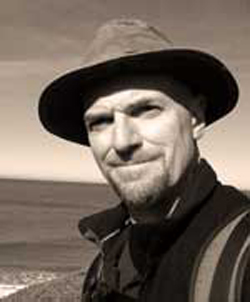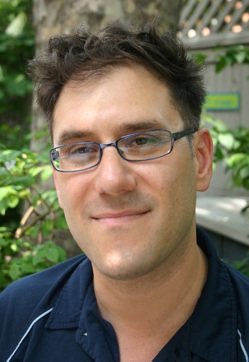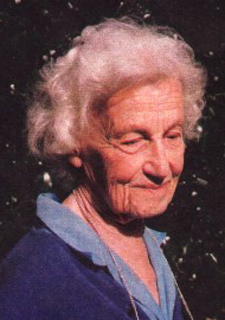By John P. O'Grady
Originally printed in the Fall 2009 issue of Quest magazine.
Citation: O'Grady, John P. "Shadow Gazing." Quest 97. 4 (Fall 2009): 148-151.
 The things of the world, according to reliable sources, are not as they appear. Nor are they otherwise. Little wonder then that so many spiritual traditions warn against the power of "false images." Consider certain venerable photographs in this regard, such as those in the family album or the old yearbook—how they attract and return the interested gaze until the image opens up like a tomb unsealed and the dead come back to life. This is the imagination let loose. The ordinary snapshot becomes a frolicsome illusion, which, if we are not careful, will lead us into delusion.
The things of the world, according to reliable sources, are not as they appear. Nor are they otherwise. Little wonder then that so many spiritual traditions warn against the power of "false images." Consider certain venerable photographs in this regard, such as those in the family album or the old yearbook—how they attract and return the interested gaze until the image opens up like a tomb unsealed and the dead come back to life. This is the imagination let loose. The ordinary snapshot becomes a frolicsome illusion, which, if we are not careful, will lead us into delusion.
Illusion and delusion: both words arise from the same Latin root, the verb ludere, "to play." Any photograph can become a playground for the mind. The favorite game here is hide-and-go-seek. You enter through a gateless gate, above which hangs a sign proclaiming, "No Adults Allowed Unless Accompanied by a Child." Ah, but like any designated playground, especially those in larger cities, this place attracts its share of shady characters, figures lurking along the edges where the carousel music fades into a dark stand of cypress.
Enthusiasts in the nineteenth century referred to the process of photography as "shadowcatching." By extension we could say that the act of viewing a photograph is a form of shadowgazing. To lavish attention upon a picture, to muse over it—or over any image, for that matter—is to get beneath its surface and become like a shade oneself, ready to join the troop of Penelope's slain suitors as they descend with their tearless escort through a cavernous expanse along a moldering path to the Land of Dreams. A photograph, says Diane Arbus, is "a secret about a secret." She is simply echoing ancient wisdom. "Believe me," writes Ovid, "an image is more than it appears to be." And St. John of Damascus declares, "Every image is a revelation and representation of something hidden." A photograph is somewhat akin to an abandoned house or a shuttered church, one of those haunted stomping grounds ripe for evocation, a place where you can petition or call forth the fantastic spirits and render the unseen seen. It's a veritable altar of Hades.
We speak of "the consumption of images," little knowing that it is the images that consume us. An image in anybody's head is wild, which is why religious authorities have always cast a wary eye on the mental habitat known as the imagination, doing their best to domesticate its remarkable fauna by herding them into the stockyards of conventional wisdom. Something inherently erotic pulses at the very core of the word "image," as its etymology indicates a "striving after" or a "rushing toward" something, like fire to fuel or lover to beloved. Thus the medieval admonishment to monks was, "It is dangerous to follow your thoughts"—thoughts in this case being images. Similarly, George Fox, founder of the Quakers, wrote: "For following thy thoughts, thou art quickly lost." And Zen lore is chock full of cautionary tales concerning those who fall victim to the "monkey mind," that ornery, craving part of ourselves that leaps recklessly from one image to the next. Parental control software is intended to restrict children's access to images on the Internet, but what is it that monitors the imaginal predilections of adults? Understood in traditional terms, a "muddled thinker" would be one who is drowning in a sea of images, unable to discriminate the good from the bad, the useful from the irrelevant.
Yet wholesale subjugation of the imagination comes at a cost. To do so is to cast ourselves into the desert of surface appearances, refusing to find any meaning in such imaginative activities as poetry, omens, or dreams; we may even cease to dream altogether. These days we have all but forgotten what Aristotle expressed so clearly almost two and a half millennia ago: "Thinking is not possible without phantasms." In other words, ideas themselves are images. Though we today distinguish "thinking" from "imagination," they are, according to ancient sources, one and the same thing. Or to speak more precisely, they are one in the same place. Diotima of Mantinea, the female philosopher who plays an important role in Plato's Symposium, explains to Socrates that the imagination is located "betwixt and between the divine and the mortal," where the mysterious agencies by which the gods communicate with mortals are free to frolic about. Neoplatonic philosophers likewise regarded the imagination as a place. Synesius of Cyrene, for instance, describes it as "the hollow gulf of the universe," abundant with fantastic intermediary places, "partly obscure and partly luminous, wherein the soul has its habitation." To think—that is, to imagine—is not so much something that we do but a realm that we enter. The invention of photography—itself a kind of theurgy or magic applied to an imaginal purpose—simply opened a new portal into this "hollow gulf of the universe."
A tale coming out of down east Maine in the late 1970s concerns a fortune-teller who employed a curious method for conducting his divinations. He was locally known as the "Snapshot Shaman," a nickname as difficult to pronounce as his talent is to believe. Word had it that he was a Zen dropout and failed astrologer who supplemented his meager income by peddling magic mushrooms. He worked out of an old barn somewhere down around Penobscot Bay. His particular gift was the ability to hold conversations with the images of dead people depicted in photographs—not all of them, apparently, for the dead can be choosy—just those who were willing to have a word with him.
As far as he was concerned, the snapshot was nothing less than a gnomic utterance or a tabernacle for tutelary deities. He was once quoted as saying, "The universe fires portents at us like hockey pucks. Unlike most people, I don't bother with keeping a goalie—mine's an open net." He had the knack of being able to slip into an old photograph like a breeze through a keyhole. A rare and undated newspaper interview offers a glimpse into his technique: "I stare at the picture of somebody and wait for the edges to catch fire, you know, in my head. It's like a bonfire in my brain. When it's all over I can see the person standing there, all shimmery, in a pile of ashes. That's when I ask them, 'How you doing?' Maybe they say something or nod their head, but a lot of the time they just keep quiet and stare at me with a kind of muffled look. Every once in a while, one of them will cock a thumb in a certain direction, meaning I should follow them, but I never do that. You just don't know where it might lead."
Even though an anthropologist at the University of Maine wrote a scathing letter to the editor dismissing the Snapshot Shaman's performances as "Halloween hokum," clients flocked to his barn from all over the region, from as far away as northern Aroostook County, bearing treasured photographs of deceased relatives in the hope that this odd man with a curious trick might coax the dearly departed into sharing a few pleasantries if not offering a heads-up on the afterlife. It was a talent that provided him with a bit of renown and a modest living, not as lucrative as, say, lobstering or robbing the vacant houses of rich summer people, but enough to pay the bills.
For a time, things went well for the Snapshot Shaman. But all that changed when a less wholesome clientele began showing up at his barn. These individuals were not interested in having a chat with dead relatives; instead, they desired more sordid truck. Such people were always male and inevitably showed up alone, swathed in an aura of dinginess. They would thrust into the shaman's hands one of those wilted photos picked up from the "instant ancestors" bin at some flea market. "Here," they would say, "this old guy looks like he didn't trust banks. Get him to tell you where he hid his money." Initially, the shaman found that he was able to cajole a few of his shadowy interlocutors into disclosing the location of their long-hidden wealth, though truth be told it never amounted to more than the occasional Indian penny or buffalo nickel. Minor exploits such as these enhanced the shaman's reputation but in the end only served to attract increasingly avaricious customers.
Then one day a dark van pulled up at the shaman's place. According to the lone witness on the scene, a strange man dressed in a soiled Nehru jacket emerged from the windowless van and walked slowly into the barn. He carried with him a large, old, leather-bound book, which he dropped with a resounding gallows thud on the shaman's consultation table. "I brought some people I'd like you to speak with," the man said in a lily-soft voice. That's when the lone witness made a shrewd decision: to hightail it out of there. Thus the record gets a little sketchy from here.
All we know for sure is that, not long after this fateful encounter, the Snapshot Shaman was committed to a mental health institute up in Bangor. Some speculate that he lost his mind after gazing into those photographs, which, they say, turned out to be in an old NYPD mug book. Others insist the shaman had simply eaten one too many a funny mushroom. In any case, he has not been heard from since. Whether he still resides in a Bangor asylum or is huddled away in a lonesome saltbox down on the Maine coast is anybody's guess. What can be said with some assurance is this was a man who trespassed into dangerous territory. He found his way there through the gateway of a photograph but did not proceed with the necessary caution and reverence. In the end, he landed in one of the many dungeons provided by the imagination for feckless prophets and errant fools.
A story such as this suggests that photography ought to be included among the "dark arts" that the Greek philosopher Gorgias condemned as "mistakes of the soul and deceptions of the understanding." Henry Fox Talbot, one of the inventors of photography, immediately recognized the occult implications of his work: "The most transitory of things, a shadow, the proverbial emblem of all that is fleeting and momentary, may be fettered by the spells of our 'natural magic' and may be fixed forever in the position which it seemed only destined for a single instant to occupy." Like necromancy or shape-shifting, photography can be a dangerous hobby if you actually get the magic to work. Luckily, for most of us it doesn't. But when an accomplished photographic artist such as the wily Walker Evans tells us, "I enjoy the human trick of turning an object into an image," there's cause for concern. The photograph possesses a Medusalike power, which most of the time lies dormant. But should it be aroused, instead of turning us into stone it joins us to the ranks of phantasms. Photography, after all, is a form of latter-day alchemy, all about turning one thing into another. Once such a powerful transforming agent is unleashed, the danger erupts that anything can become anything else. Identity itself is now dissoluble, and we are lost in a house of mirrors. "A sound magician is a mighty god," declares Dr. Faustus in the opening act of Marlowe's tragedy, but let us not forget that at the end of the play this magician is hauled off by a pack of devils.
Over the course of history, sorcerers far less capable than a Walker Evans or a Diane Arbus have been burned at the stake for exploits that, by comparison, seem mere trumpery. When Oliver Wendell Holmes famously described the photograph as "the mirror with a memory," he may well have been alluding to the "perilous mirror" of medieval legend, a false looking glass said to distort and obscure everything it reflected. John of Ruysbroeck, the great Flemish mystic, warns that we "should beware of those deceived persons who—by means of their empty, imageless state and through a bare, simple act of gazing—have found a natural way into God's dwelling." That in itself is a shocking image: the divine mansion overrun with empty-headed squatters. Yet who among us is not deceived when it comes to what's going on in our own minds?
The photograph, like the dream, the omen, or the poem, is not so much a personal creation as it is an imaginative lure, leading finally to the recognition that there is more going on—both out there in the external world and inside our heads—than we have been led to believe. Henry Fox Talbot said that one of the "charms" of a photograph is the inclusion of so many things oblivious to the maker at the time the picture was made, things that are revealed only upon subsequent contemplation. And Minor White, perhaps the most spiritually inclined photographer of the twentieth century, reminds us that the imagination recognizes no property claims. "Unlike other arts," he writes, "photographs can be made so fast that before we dare claim ownership we must study them for hours to make them ours. And even so I lately feel that even my most intimate images are only on loan to me."
We have little control over what goes into our photographs, even less over the images that come into our heads when we gaze upon them. These phantasms catch us up for a while, take possession, and lead us who knows where—into love, despair, heaven, or hell. But in the end, if we are lucky, we fall out of that enchantment back into our ordinary lives, where we might then reflect on where we've been and what we've seen. Before we go striving after the next image.
John P. O'Grady is a writer and astrologer. He is currently working on a book about the erstwhile graveyards of San Francisco. He can be contacted at johnpogrady@comcast.net, and his Web site is http://johnpogrady.com/index.html  .
.
One thousand kites in the air at the same time! This was the goal of the Wheaton Sesquicentennial Commission when they put out an all-call for kite flyers from the area to gather in one of the local parks last spring. They were hoping to set a world's record for the most kites flying at once. The winds didn't cooperate, but it was a festive gathering drawing kiters of all sorts together for the grand attempt. Although the count was a mere 800, the event created a myriad of shapes and colors dotting the skies.


 Frederick Douglass had no use for fantasies or folklore. Born a slave, he was separated as a young child from his mother—a woman who walked miles from another plantation for the rare occasion of rocking him to sleep or giving him a handmade ginger cake. He grew to be a self-educated teenager determined not to play the role of whipped dog to a cruel overseer. But in January 1834, on the eve of his sixteenth birthday, Douglass found himself delivered into the hands of the worst of them, a Mr. Covey—known as “the breaker of Negroes.”
Frederick Douglass had no use for fantasies or folklore. Born a slave, he was separated as a young child from his mother—a woman who walked miles from another plantation for the rare occasion of rocking him to sleep or giving him a handmade ginger cake. He grew to be a self-educated teenager determined not to play the role of whipped dog to a cruel overseer. But in January 1834, on the eve of his sixteenth birthday, Douglass found himself delivered into the hands of the worst of them, a Mr. Covey—known as “the breaker of Negroes.” When teaching meditation, I always suggest that we should try to listen to the sounds of the brook, birdsong, or the wind in the trees, for by so doing we open ourselves to the inner harmony of nature. It is the realization of this harmony that brings us in touch with the consciousness of the devas.
When teaching meditation, I always suggest that we should try to listen to the sounds of the brook, birdsong, or the wind in the trees, for by so doing we open ourselves to the inner harmony of nature. It is the realization of this harmony that brings us in touch with the consciousness of the devas. The things of the world, according to reliable sources, are not as they appear. Nor are they otherwise. Little wonder then that so many spiritual traditions warn against the power of "false images." Consider certain venerable photographs in this regard, such as those in the family album or the old yearbook—how they attract and return the interested gaze until the image opens up like a tomb unsealed and the dead come back to life. This is the imagination let loose. The ordinary snapshot becomes a frolicsome illusion, which, if we are not careful, will lead us into delusion.
The things of the world, according to reliable sources, are not as they appear. Nor are they otherwise. Little wonder then that so many spiritual traditions warn against the power of "false images." Consider certain venerable photographs in this regard, such as those in the family album or the old yearbook—how they attract and return the interested gaze until the image opens up like a tomb unsealed and the dead come back to life. This is the imagination let loose. The ordinary snapshot becomes a frolicsome illusion, which, if we are not careful, will lead us into delusion.